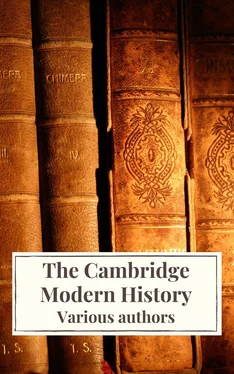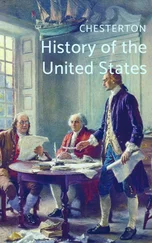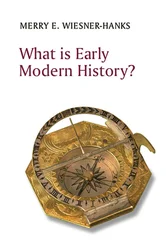R. Nisbet Bain - The Cambridge Modern History
Здесь есть возможность читать онлайн «R. Nisbet Bain - The Cambridge Modern History» — ознакомительный отрывок электронной книги совершенно бесплатно, а после прочтения отрывка купить полную версию. В некоторых случаях можно слушать аудио, скачать через торрент в формате fb2 и присутствует краткое содержание. Жанр: unrecognised, на английском языке. Описание произведения, (предисловие) а так же отзывы посетителей доступны на портале библиотеки ЛибКат.
- Название:The Cambridge Modern History
- Автор:
- Жанр:
- Год:неизвестен
- ISBN:нет данных
- Рейтинг книги:4 / 5. Голосов: 1
-
Избранное:Добавить в избранное
- Отзывы:
-
Ваша оценка:
- 80
- 1
- 2
- 3
- 4
- 5
The Cambridge Modern History: краткое содержание, описание и аннотация
Предлагаем к чтению аннотацию, описание, краткое содержание или предисловие (зависит от того, что написал сам автор книги «The Cambridge Modern History»). Если вы не нашли необходимую информацию о книге — напишите в комментариях, мы постараемся отыскать её.
The first series was planned by Lord Acton and edited by him with Stanley Leathes, Adolphus Ward and George Prothero.
The Cambridge Modern History Collection features all five original volumes:
Volume I: The Renaissance
Volume II: The Reformation, the End of the Middle Ages
Volume III The Wars of Religion
Volume IV: The 30 Years' War
Volume V: The Age of Louis XIV
The Cambridge Modern History — читать онлайн ознакомительный отрывок
Ниже представлен текст книги, разбитый по страницам. Система сохранения места последней прочитанной страницы, позволяет с удобством читать онлайн бесплатно книгу «The Cambridge Modern History», без необходимости каждый раз заново искать на чём Вы остановились. Поставьте закладку, и сможете в любой момент перейти на страницу, на которой закончили чтение.
Интервал:
Закладка:
As a pupil of Deventer, Nicholas Krebs had been brought up in a devout atmosphere. The times drove reformers to take sides with a Council which was certain, against a Pope who was doubtful; and while Archdeacon of Lüttich, Cusanus at Basel in 1433 repeated and enforced the deposing maxims which he had learnt from Pierre d’Ailly. His pamphlet On Catholic Concord gave the Fathers in that assembly a text for their high-handed proceedings. But events opened his eyes. Though he had contributed not a little to the “Compact” by which peace was made with the Bohemians, yet, like Cesarini, this learned and moderate man felt that he could no longer hold with a democratic party pledged to everlasting dissensions. He submitted to Eugenius IV. At Mainz and Vienna in 1439 he appeared as an advocate of the papal claims. Two years later Eugenius associated him with Carvajal, of whom more will be said below, on the like errand. Nicholas V in 1451 gave him a legatine commission to Bohemia; and again he was united with a vehement Church reformer, the Neapolitan Capistrano, who was preaching to great multitudes in Vienna and Prague.
This renowned progress of Cusanus which, beginning in Austria, was extended to Utrecht, certainly sheds lustre on the lowly-born Pope, who had invested him with the Roman purple, appointed him Bishop of Brixen, and bestowed on him the amplest powers to visit, reform, and correct abuses. Yet the Council of Basel, so anarchical when it attempted to govern the Church, must share in whatever credit attaches to the work of the Legate. For the Conciliar decree which ordered Diocesan Synods to be held every year and Provincial every three years, set on foot a custom fraught in the sequel with large and admirable consequences. We possess information with regard to some two hundred and twenty Synods which were held in various parts of Europe between 1431 and 1520. Of these Germany claims the larger number; France follows no long way behind; but Italy reckons few in comparison, nor are these so important as the Councils which were celebrated beyond the Alps. At Florence, indeed, East and West for a moment joined hands. But the union of the Churches was one of name rather than of fact; it melted away before popular hatred in the Greek provinces; and its gain to Latins may be summed up in the personality, the scholarship, and the library of Bessarion, who spent his days on the futile embassies by which he hoped to bring about a new crusade. The reform of discipline, which in almost every diocesan or provincial Synod became the chief subject of argument and legislation, was not undertaken at Florence.
Not doctrine but canon law occupied the six local assemblies at Terguier between 1431 and 1440; the two held at Beziers in 1437 and 1442; and that which met at Nantes in 1445 and 1446. Italy had its Council of Ferrara in 1436; Portugal in the same year met in Council at Braga under Archbishop Fernando Guerra. German Synods were held frequently about this period, at Bamberg, Strassburg, Ratisbon, and Constance. At Salzburg in 1437 a code of reform was drawn up which other Councils repeated and enforced. It dealt with Reservations,—that deadly plague of papal and episcopal finance; with the moral disorders of the clergy; and with many abuses the effects of which have been strongly depicted in Protestant satires. The Synod of Freising in 1440 condemned usury and was loud in its denunciation of Jew money-lenders. There was a Synod of London in 1438; Edinburgh held another in 1445. The numerous and well-considered statutes of Söderköping, over which the Archbishop of Upsala presided in 1441, and of other assemblies in Scandinavia between 1443 and 1448, reveal the widespread evils from which religion was suffering; they insist on prayers in the vernacular, on frequent preaching, on a stricter discipline among the clergy. A French Synod at Rouen in 1445, which enacted forty-one canons, condemned in emphatic terms witchcraft and magic and many other popular superstitions, together with the non-residence of beneficiaries and the tax which prelates were not ashamed to gather in from priests who kept concubines. At Angers in 1448 a severe attack was made upon the traffic in spurious relics and false indulgences. Many strokes might be added to this picture; but there is an inevitable monotony, as in the abuses painted, so in the remedies proposed for them, none of which laid the axe to the root. Unless princes and nobles could be hindered from masquerading as bishops, though destitute of piety, learning, and vocation, the ancient evils must continue to flourish. The odious charges laid on a poverty-stricken clergy, at once too numerous and too heavily burdened, which took from them their first-fruits, their tenths, their fifteenths, were not abolished in a single one of these Councils. Nor was the abominable practice of charging money-dues on every office of religion abandoned, until the floods came and the great rains fell which threatened the house with destruction. The master-idol which it was impossible to pull down was Mammon. Culture was ruined by immorality, and religion itself by simony; while for the sake of a living crowds professed rules of perfection which they made little or no attempt to observe.
Yet Cusanus showed them a more excellent way. In February, 1451, he began to execute his legatine commission at Salzburg, where he presided over a local Synod. He travelled in unpretending guise, preached wherever he came, and displayed zeal and even tact, which was not his special quality, in reconciling the parish clergy with the Mendicants, and in bringing back monastic discipline to its former purity. At Vienna, in March, he appointed three visitors to the Austrian houses of St Benedict, then by no means attached to Rome. Fifty convents, in due time, accepted the reform. Cusanus took in hand the Augustinian Canons, held a Synod at Bamberg, and endeavoured to regulate the troublesome question of Easter Confession to the parish priest, on which strife was constantly arising with the friars. At Würzburg he received the homage of seventy Benedictine Abbots, who promised obedience to his decrees; though all did riot keep their engagement. The Bursfelde Congregation, which brought under strict observance as many as eighty-eight abbeys and several nunneries, was already nourishing. It had been set up by John Dederoth of Minden, who became Abbot of Bursfelde in 1433, and was closely allied with another zealous reformer, John Rode of St Matthias at Trier. But the original impulse appears to have been derived from the Augustinian houses which had adopted the rule of Windeshem, and the famous John Busch may be named in the present connexion. This indefatigable preacher visited and succeeded in reforming a large number of convents in Thuringia and the adjacent parts. Cusanus examined and approved the statutes of Bursfelde in May, 1451. He appointed visitors to the convents of Thuringia, and in June opened the Synod of Magdeburg, which passed the usual decrees touching reform of the monasteries, concubinary priests, and economic oppression as practised by Hebrew money-lenders. But his next proceeding, an attempt to put down the pilgrimage to the “Miraculous Host” of Wilsnack, was the beginning of great troubles and met with no success.
Archbishop Frederick of Magdeburg, who had supported the Cardinal in this attempt, was however an opponent of John Busch, and in 1454 the latter returned to Windeshem, so that the decrees of Cusanus were not in the end carried out. He, meanwhile, continued his visitation at Hildesheim and Minden. In August he was at Deventer, whither much business followed him. The Holy See extended his legatine powers to Burgundy and England; but in what manner this part of his mission was fulfilled does not seem clear. That he fell into a serious illness, from which he did not recover until February, 1452, may be ascribed to his apostolic labours and journeyings. It had been his intention to preside at the Synod of Mainz, which was opened in his absence by Archbishop Dietrich, in March, 1452, and which repeated the enactments of Magdeburg against usury, clerical concubines, vagrant collectors of alms, and the holding of markets on feast-days. Other decrees imply that superstition was rife, and that crime was not unknown in holy places. The Cardinal confirmed these statutes, which were published in many diocesan Synods. In March, 1452, he presided over a gathering at Cologne in which twenty-one decrees were published, all indicating how deep and wide were the wounds of religion in the German Church, the wealthiest and the most feudalised in Christendom, and how little prospect there was of healing them. It is not the way of religious Councils to legislate for evils which do not exist or have attained only slender proportions; and we must conclude from the reiterated acts of authority that all over the West the bonds of discipline were loosened; that clerics in various places broke their vows with the connivance of bishops; that into some convents vice had found an entrance; and that many more had lapsed into ease and sloth. Yet in the largest houses immorality was rare; nor did Lutheranism receive its first impulse from the relaxation of conventual rule. That the clergy as a body were throughout this period corrupt or immoral, is an assumption unsupported by definite evidence.
Читать дальшеИнтервал:
Закладка:
Похожие книги на «The Cambridge Modern History»
Представляем Вашему вниманию похожие книги на «The Cambridge Modern History» списком для выбора. Мы отобрали схожую по названию и смыслу литературу в надежде предоставить читателям больше вариантов отыскать новые, интересные, ещё непрочитанные произведения.
Обсуждение, отзывы о книге «The Cambridge Modern History» и просто собственные мнения читателей. Оставьте ваши комментарии, напишите, что Вы думаете о произведении, его смысле или главных героях. Укажите что конкретно понравилось, а что нет, и почему Вы так считаете.












